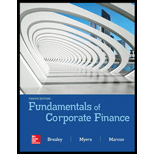
a.
To determine: The EPS of the merged firm.
a.
Answer to Problem 5QP
The EPS of the merged firm is $4.20.
Explanation of Solution
Determine the EPS and total earnings of Company CS
Therefore, the EPS is $4 and total earnings is $8,000,000.
Determine the EPS and total earnings of Company FF
Therefore, the EPS is $2.50 and total earnings is $2,500,000.
Determine the EPS of the merged firm
Therefore, the EPS of merged firm is $4.20.
b.
To determine: The price per share of Company CS.
b.
Answer to Problem 5QP
The price per share of Company CS is $40.
Explanation of Solution
Determine the price per share of Company CS
Therefore, the price per share of Company CS is $40.
c.
To discuss: The demonstration of Company CS or Company FF realize any change in wealth.
c.
Answer to Problem 5QP
The value of Company CS and Company FF is Unchanged.
Explanation of Solution
- Company FF have a stock worth of $20,000,000 ($40*500,000 shares), so the wealth of Company FF is unchanged.
- The wealth of Company CS is also unchanged.
Therefore, the value of Company CS and Company FF is Unchanged.
d.
To determine: The P/E ratio of new firm if there are no economic gains.
d.
Answer to Problem 5QP
The P/E ratio of new firm if there are no economic gains is 9.52.
Explanation of Solution
Determine the P/E ratio of new firm if there are no economic gains
The P/E ratio of the merged firm is between the P/E ratio of the two firms.
Therefore, the P/E ratio of new firm if there are no economic gains is 9.52.
e.
To determine: The price per share of Company CS.
e.
Answer to Problem 5QP
The price per share of Company CS is $42.
Explanation of Solution
If the P/E ratio of Company CS remains constant at 10, then the merged firm will the share price at $42 per share ($4.20*10). This will result in an increase in the firm value to $105,000,000 ($42*2,500,000).
Therefore, price per share of Company CS is $42.
f.
To determine: The gains from the merger split between shareholders of the two firms.
f.
Answer to Problem 5QP
The gain of Company CS is $4,000,000 and Company CS is $1,000,000.
Explanation of Solution
Determine the gain of Company CS and Company FF
Therefore, the gain of Company CS is $4,000,000 and Company CS is $1,000,000.
Want to see more full solutions like this?
Chapter 21 Solutions
FUNDAMENTALS OF CORPORATE FINANCE
- see itPlease don't answer i posted blurred image mistakely. please comment below i will write values. if you answer with incorrect values i will give unhelpful confirm.arrow_forwardNo use ai. if image is blurr or data is not showing properly then dont answer i will sure deslike. please comment i will write values.arrow_forwardDon't use ai. if image is blurr or data is not showing properly then dont answer i will sure deslike. please comment i will write values.arrow_forward
- no ai Please don't answer i posted blurred image mistakely. please comment below i will write values. if you answer with incorrect values i will give unhelpful confirm.arrow_forwardFinance SubjPlease don't answer i posted blurred image mistakely. please comment below i will write values. if you answer with incorrect values i will give unhelpful confirm.arrow_forwardcalculate ratios for the financial statment given and show all working manually: 3. TIE Ratio 4. Cash Coverage Ratioarrow_forward
- calculate ratios for the financial statment given and show all working manually: 1. Debt Ratios 2. Debt to Equityarrow_forwardcalculate the following ratios for the statements and show all working: 1. Current Ratios 2. Quick Ratio 3. Cash Ratioarrow_forwardDont solve this question with incorrect values. i will give unhelpful . do not solvearrow_forward
 Essentials Of InvestmentsFinanceISBN:9781260013924Author:Bodie, Zvi, Kane, Alex, MARCUS, Alan J.Publisher:Mcgraw-hill Education,
Essentials Of InvestmentsFinanceISBN:9781260013924Author:Bodie, Zvi, Kane, Alex, MARCUS, Alan J.Publisher:Mcgraw-hill Education,

 Foundations Of FinanceFinanceISBN:9780134897264Author:KEOWN, Arthur J., Martin, John D., PETTY, J. WilliamPublisher:Pearson,
Foundations Of FinanceFinanceISBN:9780134897264Author:KEOWN, Arthur J., Martin, John D., PETTY, J. WilliamPublisher:Pearson, Fundamentals of Financial Management (MindTap Cou...FinanceISBN:9781337395250Author:Eugene F. Brigham, Joel F. HoustonPublisher:Cengage Learning
Fundamentals of Financial Management (MindTap Cou...FinanceISBN:9781337395250Author:Eugene F. Brigham, Joel F. HoustonPublisher:Cengage Learning Corporate Finance (The Mcgraw-hill/Irwin Series i...FinanceISBN:9780077861759Author:Stephen A. Ross Franco Modigliani Professor of Financial Economics Professor, Randolph W Westerfield Robert R. Dockson Deans Chair in Bus. Admin., Jeffrey Jaffe, Bradford D Jordan ProfessorPublisher:McGraw-Hill Education
Corporate Finance (The Mcgraw-hill/Irwin Series i...FinanceISBN:9780077861759Author:Stephen A. Ross Franco Modigliani Professor of Financial Economics Professor, Randolph W Westerfield Robert R. Dockson Deans Chair in Bus. Admin., Jeffrey Jaffe, Bradford D Jordan ProfessorPublisher:McGraw-Hill Education





